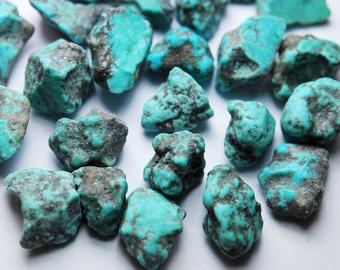Turquoise

No rock identifies with the desert southwest U.S. as much as turquoise. The principal stone of native american jewelry has etched itself into the public consciousness. Usually set in silver, this distinctive stone casts various yet striking coloring in a spectrum from blue to green, usually depending on which mine it came from.
Turquoise, a member of the copper complex family, is typically a very soft stone, chalky in fact. With the exception of extremely rare samples that have been heavily silicified, also known as gem silica. Most people don't know that 95% of turquoise jewelry/stone on the market is not native, rather it is reconstituted. What this means is that the stone is pulverized into a powder and mixed with resin or epoxy as a stabilizing agent. The resulting material is hard enough to cut and polish into cabochons. Other turquoise processors stabilize the stone with proprietary techniques designed to bring hardness to this otherwise soft stone.
Native turquoise is rare, and getting more expensive with each passing year. Several of the well-known mines have closed, and remaining claims aren't producing the quality and quantity of years past. In fact, the best source of native turquoise is to find some old stock.
I have a very small amount of native turquoise in my collection that I'll probably keep as specimens. So, chances are that if you get any of my turquoise jewelry, it is likely made from recon. Beautiful none the less.
One more thing... to the untrained eye, some chrysocolla can be confused as turquoise. Granted, it's all the same copper mineral in some state of oxidation, but after seeing lots of the stuff, you get an eye to spot the distinction. If you ever see someone at a gem show holding turquoise up to their lip, they are testing for native specimens. Stabilized turquoise will not 'pull' on a moist lip.